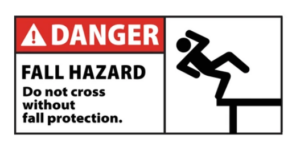Moffitt Fall Protection Safety
Falls Are the Leading Cause of Death in Construction. In 2018, there were 320 fatal falls to a lower level out of 1,008 construction fatalities (BLS data). All these deaths could be prevented with sufficient fall protection safety. They’ve produced the Plan, Provide, Train program to help people learn how they can prevent falls. As an industrial ventilation company our employees spend a lot of time on roofs. That’s why we decided to spread the message to our team as well as our customers by sharing the suggestions here.
 PLAN ahead to get the job done safely
PLAN ahead to get the job done safely
When working from elevated heights employers must plan to ensure that the job is done safely. Employers determine what safety equipment is optimal to complete each task safely. This includes planning for safety equipment and making all the necessary equipment and tools available at the construction site.
For example, in a roofing job, the employer must think about all the different fall hazards. This includes holes, skylights, and leading edges. Next, they must determine the fall protection suitable to that work, such as personal fall arrest systems (PFAS).
At Moffitt, we plan by preparing the Site-Specific Safety Plan, which includes a fall protection plan specific to the project. These plans should include any customer-provided safety requirements and our subcontractor’s safe work plan. Any Moffitt representative onsite should be adhering to the plan and ensuring that the subcontractor is adhering to the plan. If not, address the safety infraction with the subcontractor’s site superintendent or directly with the crew member.
PROVIDE the right equipment
Workers who are six feet or more above lower levels are at risk for severe injury or death if they should fall. To protect these workers, employers must provide fall protection and the right equipment for the job. The right equipment may include ladders, scaffolds, and safety gear depending on the job site.
It is imperative to choose the right ladder or scaffold to get the job done safely. For roof work, if workers use personal fall arrest systems (PFAS), the company should provide a harness for each worker. This will ensure that everyone working at elevation ties off to the anchor. Make sure the PFAS fits, and regularly inspect it for safe use.
Moffitt has increased safety planning by utilizing a Fall Protection Plan and Fall Hazard Survey to identify the correct safety equipment systems and site-specific fall protection required for each job. When working with a MCI, the Moffitt team works on a collaborative site-specific fall protection plan. Be proactive by utilizing Personal Fall Limiter Systems (PFLS). PLFLS arrest falls before they become fatal. Employers should provide fall protection on all projects.
TRAIN everyone to use the equipment safely
Workers train on proper set-up and safe use of equipment they use on the job. Employers must train workers in recognizing hazards on the job. Employers must also show employees how to utilize the safety equipment. Training on the proper fit of harnesses, correct usage of lanyards or retractables, and when fall protection is appropriate, ensure a safe crew.
In conclusion, the entire Moffitt team takes safety training seriously. For 2021, February is our safety month. We’re observing proper safety procedures, like fall protection, all month long. We’re discussing plans, providing equipment, and training everyone to be ready for roof work for the rest of the year and the future.
At Moffitt, safety is always job one.
Sources: https://www.osha.gov/stopfalls/
